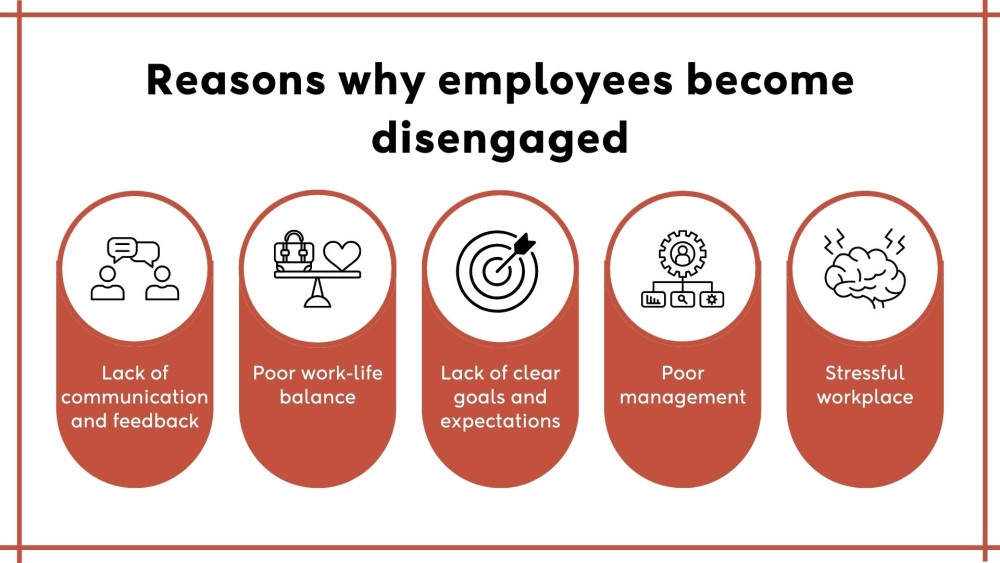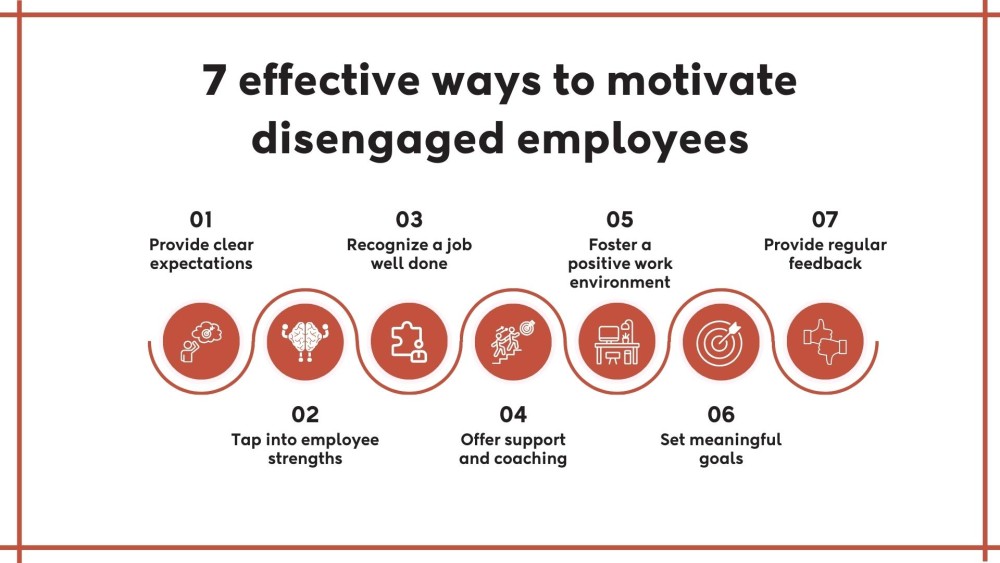A recent survey by Gallup states that 85% of employees are not engaged at work.
Disengaged employees are a massive challenge for any organization. They lead to decreased productivity, low morale, and high turnover rates.
If you are reading this blog, you must be dealing with disengaged employees in your team. You are likely on the lookout for a solution to motivate them.
You have come to the right place, there are ways to turn things around.
In this article, you will get seven effective ways to motivate your team members. But before that, let’s cover the reasons why your team members become disengaged.
Reasons why employees become disengaged

Your team might not be as engaged as you’d like. There are different reasons responsible for disengaging employees at your workplace. Let’s look at some common ones:
- Lack of communication and feedback
Employees thrive on clear communication and feedback. When you fail to communicate well, your team members feel alone. They might not know how they are doing if you don’t give helpful feedback.
Employees may not understand their roles or the company’s goals without communication. Not getting feedback means they won’t know how to improve or see if their efforts are paying off. This makes them feel like they are missing a sense of purpose and accomplishment.
- Poor work-life balance
A survey by CareerBuilder finds that 61% of respondents are burned out on the job.
Your team members might feel burned out when work takes up too much of their time. They struggle with poor work-life balance. This can make them less productive and motivated.
Working long hours and having a schedule that’s not flexible can mess up their personal life. It causes stress and makes them feel like their job doesn’t care about their well-being. This feeling can make them disengaged, and they might look for a job that supports them better.
Discover strategies to maintain work-life balance in the workplace.
- Lack of clear goals and expectations
When team members are not sure about what’s expected of them, they get confused. The unclear goals they’re supposed to achieve lead to frustration. This lack of clarity can make it hard for them to stay motivated.
If goals keep changing all the time, it adds to the confusion. It becomes challenging for team members to concentrate on their work or see how well they can do.
- Poor management
Employees feel undervalued if there is poor management in the organization. They seek feedback, recognition, or chances to grow. When there’s no appreciation or direction, motivation and engagement go down.
When managers don’t support or help their team, it breaks their trust and lowers happiness. As a result, employees become less committed to the organization.
- Stressful workplace
Having too much work or a bad work environment leads to stress. It can hurt both the mental and physical health of your team.
Too much stress at work can make your team members feel unhappy. They skip work more often, making it more likely for them to quit.
Employees start to lose interest in their jobs and want a better, more positive workplace.
Dealing with stress? Learn everything about work stress and anxiety and how to deal with it.
7 effective ways to motivate disengaged employees

A joint study on employee engagement shows that companies lose $450-$550 billion per year due to disengaged employees.
That’s a huge loss!
Making it necessary more than ever for the managers to motivate their employees. Here are 7 practical ways to motivate your employees:
- Provide clear expectations
As a manager, make sure your team knows what’s expected. They can focus on important tasks when they understand their roles and goals. This focus gives them a sense of purpose and accomplishment.
Clear expectations reduce uncertainty, making your team confident. Knowing their contributions match organizational goals makes them feel important. This feeling boosts their job satisfaction.
- Tap into employee strengths
Identifying each team member’s strengths is crucial. It helps employees use their skills and interests in tasks that suit them best. When work aligns with what they’re good at, they feel satisfied and excited.
Saying, “You’re really good at this,” boosts employee’s confidence. It shows them they matter. When tasks fit their strengths, they like their job more and feel more motivated overall.
- Recognize a job well done
When you regularly appreciate your team, it boosts their spirits. They feel good about their hard work. This connection between recognition and positive feelings is crucial.
If you acknowledge their efforts, it’s like giving them a pat on the back for a job well done. This positive boost makes them feel accomplished. It inspires them to give their best.
- Offer support and coaching
Your constant support shows your team that you are serious about their growth. You want to help them learn and improve skills. It builds a culture where people feel important and appreciated.
Giving chances to learn makes your team feel like they’re moving forward. It also gives them a sense of accomplishment. When they see the company is committed to helping them succeed, it keeps them motivated.
- Foster a positive work environment
Creating a positive workplace is vital for your team’s well-being. When you make your team members feel valued and supported, they’re more likely to stay engaged.
Encourage positive interactions, teamwork, and open communication. A supportive environment builds strong relationships. It makes work more enjoyable and motivating for everyone.
Explore practical tips to create a positive work environment.
- Set meaningful goals
Setting clear and essential goals gives your team a sense of purpose. When you work together to set these goals, team members connect with their work on a personal level. This connection boosts engagement among your team.
Make sure the goals are challenging but doable. This keeps your team motivated and determined. Team members work hard to achieve their aligned goals. These goals keep them engaged and committed to the job.
- Provide regular feedback
A survey conducted by SHRM reveals that 89% of HR professionals believe ongoing feedback and clear expectations improve employee engagement.
Giving feedback helps your team keep getting better. Your team members will know how they’re doing and where they can improve. This creates a vibe of learning and growing in your team.
When you give constructive feedback, it boosts your team’s motivation. It shows them a straightforward way to grow in their personal and professional life.
Conclusion
To put it briefly, employees are one of the greatest assets you have in the organization. As a manager, you should encourage, stimulate, and motivate your team members. This way, you will get the best out of your workforce.
We have outlined seven effective ways to motivate them. Additionally, we explored why employees get disconnected in the first place. By encouraging open communication and recognizing contributions you can boost employee engagement.
FAQs
How can I recognize disengaged employees?
Signs of disengagement include decreased productivity and lack of enthusiasm. Additionally, increased absenteeism and poor teamwork are indicators to watch out for.
Regular communication, surveys, and performance evaluations can help identify disengaged individuals.
What are the negative effects of disengaged employees?
Disengaged employees can have a significant negative impact on an organization. Negative effects include decreased productivity and increased turnover rate. These issues can also damage the company culture.
How can I measure employee engagement?
You can take employee surveys to gather feedback from employees. You can cover work relationships and overall experience of the company culture.
As a manager, you can also conduct exit interviews. These interviews help gather feedback from employees who are leaving the company.
What are the benefits of motivating disengaged employees?
Motivating disengaged employees brings higher productivity, reduces absenteeism, and lowers turnover rates. Additionally, it fosters an environment that promotes increased innovation.




















No Comments